Terry Doe tests out the Kral Arms Puncher Knight - a fantastic PCP sidelever that Terry declares a "remarkable rifle at a remarkable price"...
Assessing an airgun can be as straightforward or as complicated as you want it to be. I’m not a complex person, so my testing criteria are based around a basic combination of factors. I study how well an airgun shoots and handles, the quality of its construction, the ease and practicality of using it, and its price. These are the components that make or break an airgun, and in my experience, when these vital elements are in place, the airgun will look right as well, which is also essential, despite what some may tell you. This month’s test rifle scores highly in every category, and it costs just £575, or less, and I’m going to open this review by declaring the Puncher Knight the best Kral Arms rifle I’ve handled.
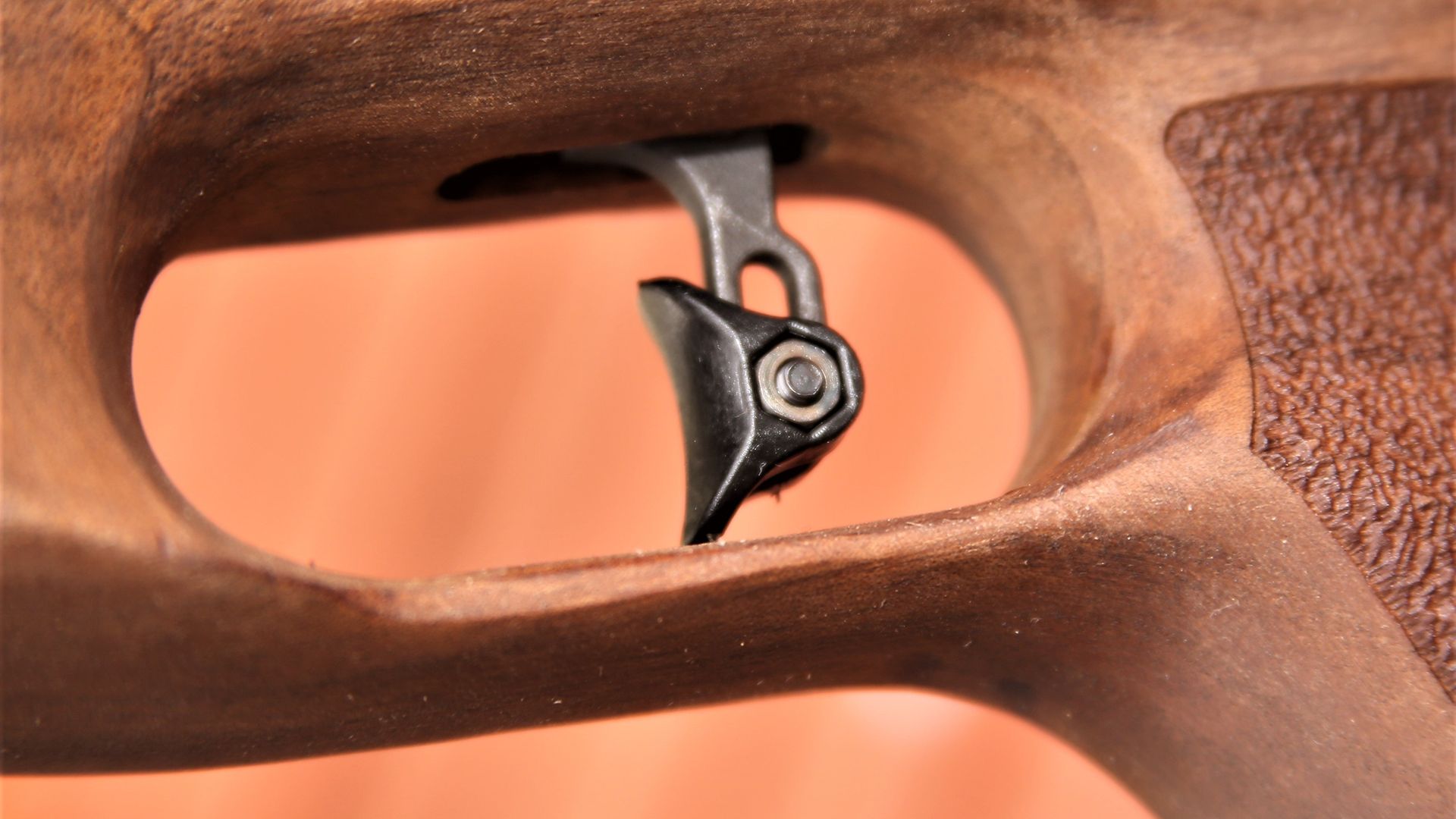 credit: Archant
credit: Archant
OVERVIEW
The sidelever, semi-bullpup Kral Arms Knight is available in a fully-synthetic, ambidextrous thumbhole stock, or in oiled walnut, as shown here. It has a variable power function, which would be more useful on high-power FAC models, but could earn its keep during training sessions, or in situations where 12 ft.lbs. is more than required, such as for clearing feral pigeons or rats at close quarters.
With an overall length of 920mm (36 inches) without a silencer, and an unscoped weight that hovers just below 4 kilos (8.9lbs), the Knight is still fairly compact, but it’s definitely an adult rifle. That 500cc buddy bottle, shrouded, 580mm (23-inch) barrel assembly, ‘reach-forward’ Picatinny scope mounting rail and the substantial action block, impart an overall impression of solidity, which isn’t an illusion by any means. This is a robust rifle from its threaded muzzle, all the way back to its adjustable butt pad.
As with all rifles of this design, the weight is pulled back toward the shooter, and once the Knight is in the shoulder, its heft contributes positively toward on-aim stability, rather than exacting a penalty. Kral’s concept team got its priorities right, and quite correctly, the Knight is designed to be shot, rather than carried.
In the supplied padded hard case, you’ll also find two, removeable, rotary multi-shot magazines – 12-shot in .22 and 14 in .177 – plus a single-shot pellet tray, a push-fit charging connector, hex wrenches, a short section of fore-end rail for fitting a sling or a bipod, and a comprehensive instruction manual.
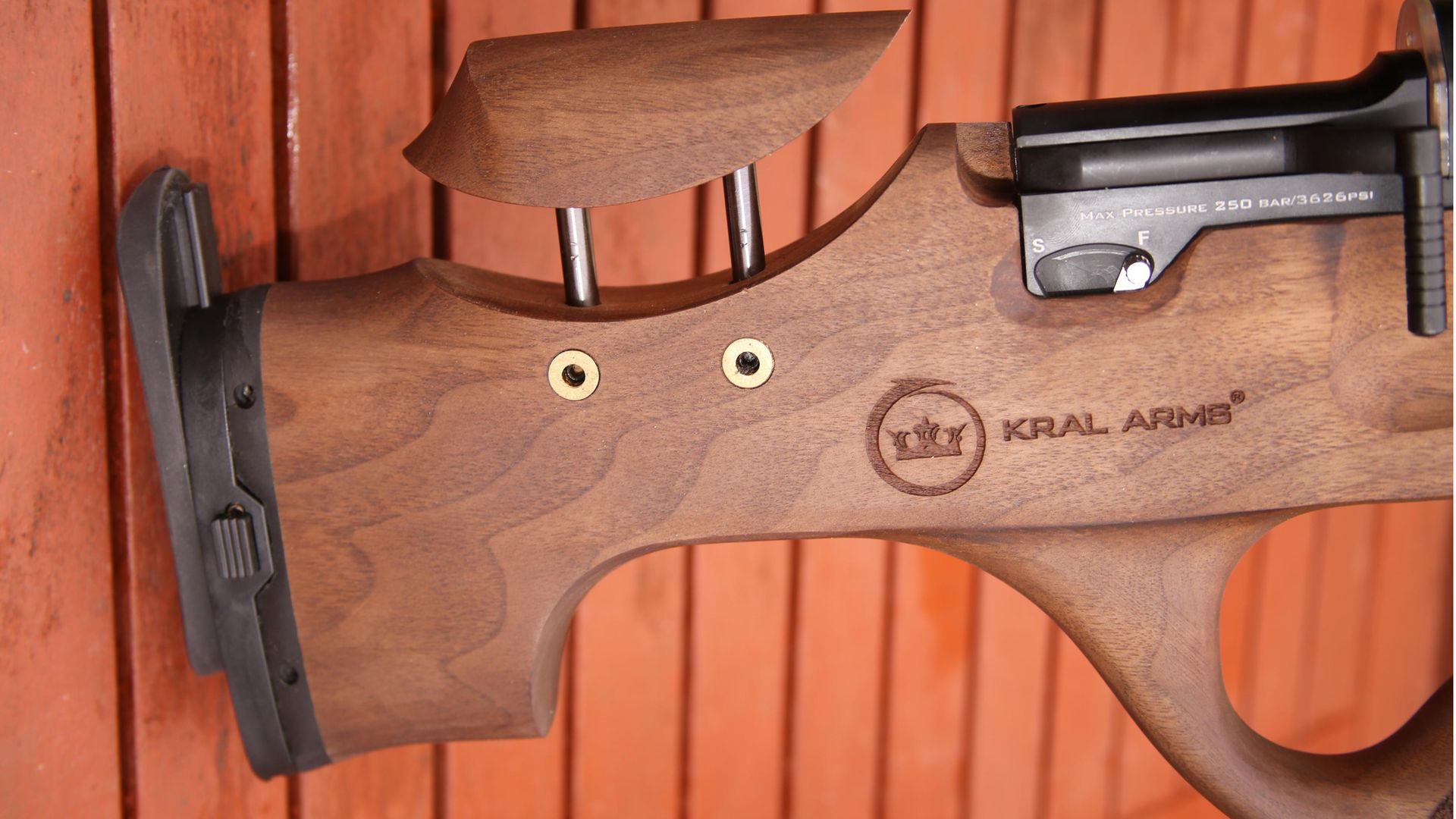
FEATURES RUNDOWN
Starting with the walnut stock, the first thing I noticed was that it was looking decidedly ‘thirsty’, especially where the adjustable cheek piece had been cut. I immediately rubbed in some walnut oil and repeated the treatment as I studied the rifle’s features. Stock oil isn’t just for aesthetic reasons, it’s a front-line protection method, so if your stock needs a quick massage, get it done before moisture ingress and cracking timber makes you wish you’d sorted it sooner.
The design of the Knight’s woodwork reflects the chunky solidity of the action, with no areas of vulnerable timber and a single recessed fixing through the grip. A threaded brass insert beneath the fore end takes the supplied accessory rail, with matching inserts below the adjustable cheek piece to release it or lock it in place.
An accommodating scoop provides clearance between your fingers and the sidelever, with more of the same around the manual, resettable safety catch, whilst various curves and cutaways lighten the load physically and on the eye, again without weakening the woodwork. At the angled grip, you’ll find a stippled panel surrounding the palm swell design, along with another scoop that guides the finger toward the rifle’s adjustable trigger shoe.
Now include those vital adjustments at the cheek piece and butt pad, and this rifle adds a commendable degree of control to its qualities of strength and convenience. This is an extremely well-designed rifle stock at any price, let alone the £575 tag carried by the Kral Arms Knight.
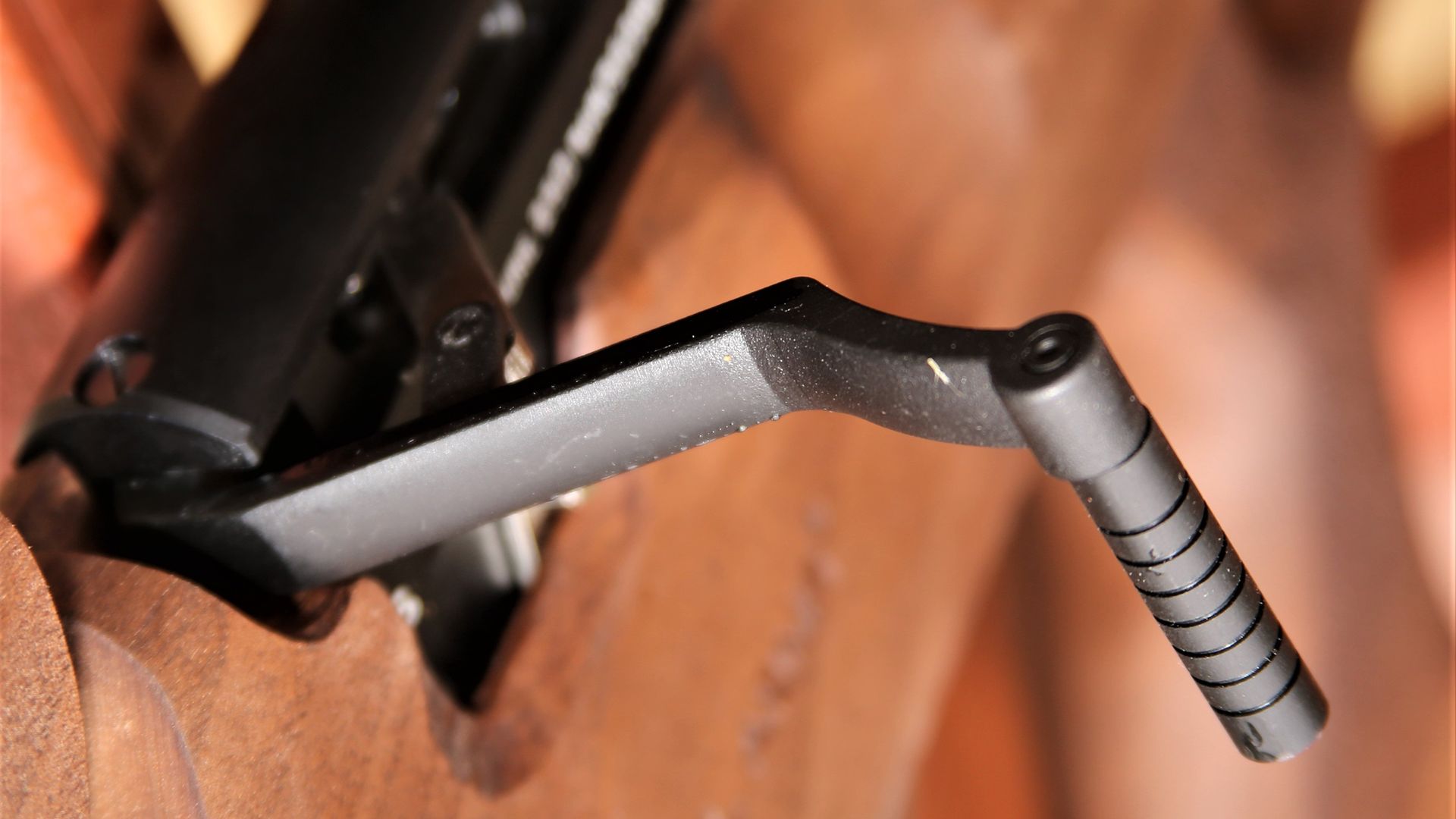 credit: Archant
credit: Archant
ACTION INSPECTION
As previously stated, the Knight is a solid piece of kit and each component seems to be there for the long haul. The 200mm (7.8-inch), Picatinny sight mounting rail is fixed top and bottom to the rifle’s action block, bridging the shrouded barrel assembly and the buddy-bottle’s point of attachment. Bevels on the vertical faces of this ‘wraparound’ mount and channels on the sides of the action exist purely to make the rifle look less ‘blocky’, and yet again, this shows attention to detail on behalf of Kral’s designers. This and other small but significant details reinforce the thought that has been invested in this model, and the more I explore the Knight, the more impressed I am by it, and by those who produce it.
The Knight is finished in a combination of anodised matte-black on the action block and scope rail, a silky bluing on the steel barrel shroud, and a gloss black on the buddy bottle. Overall, my close inspection, albeit without removing the rifle’s stock, reveals a robust, well-made sporter that’s designed to offer many years of service.
Clipping the supplied charging connector to the male spigot on the left-hand side of the Knight’s action block introduced me to the two features I liked least. That charging nozzle not only sticks out, it’s protected by a slippery rubberised cap that I struggled to remove with my oily fingers. On the flip side of the Knight, the on-board pressure gauge has a similarly annoying amount of ‘sticky-outness’, and unless there’s a technical reason for both degrees of clearance from the stock, I’m amazed they got past Kral’s designers. That said, you’ve just read my only moans about this rifle, so that says plenty about the rest of it.
Meanwhile, injecting the recommended 200 bar of air into the Knight’s 500cc reservoir takes a considered 10 seconds, or at least it should if you do it gradually to get a full charge, and with the .22 rifle on test, you’re good to go for around 200 shots at 11.5 ft.lbs. Individual rifles will have their own charging pressure preferences, up to the 250 bar maximum, of course, and it could be worth experimenting, but 200 bar produced the best band of consistent shots from the test rifle, and I’ll be sticking with that.
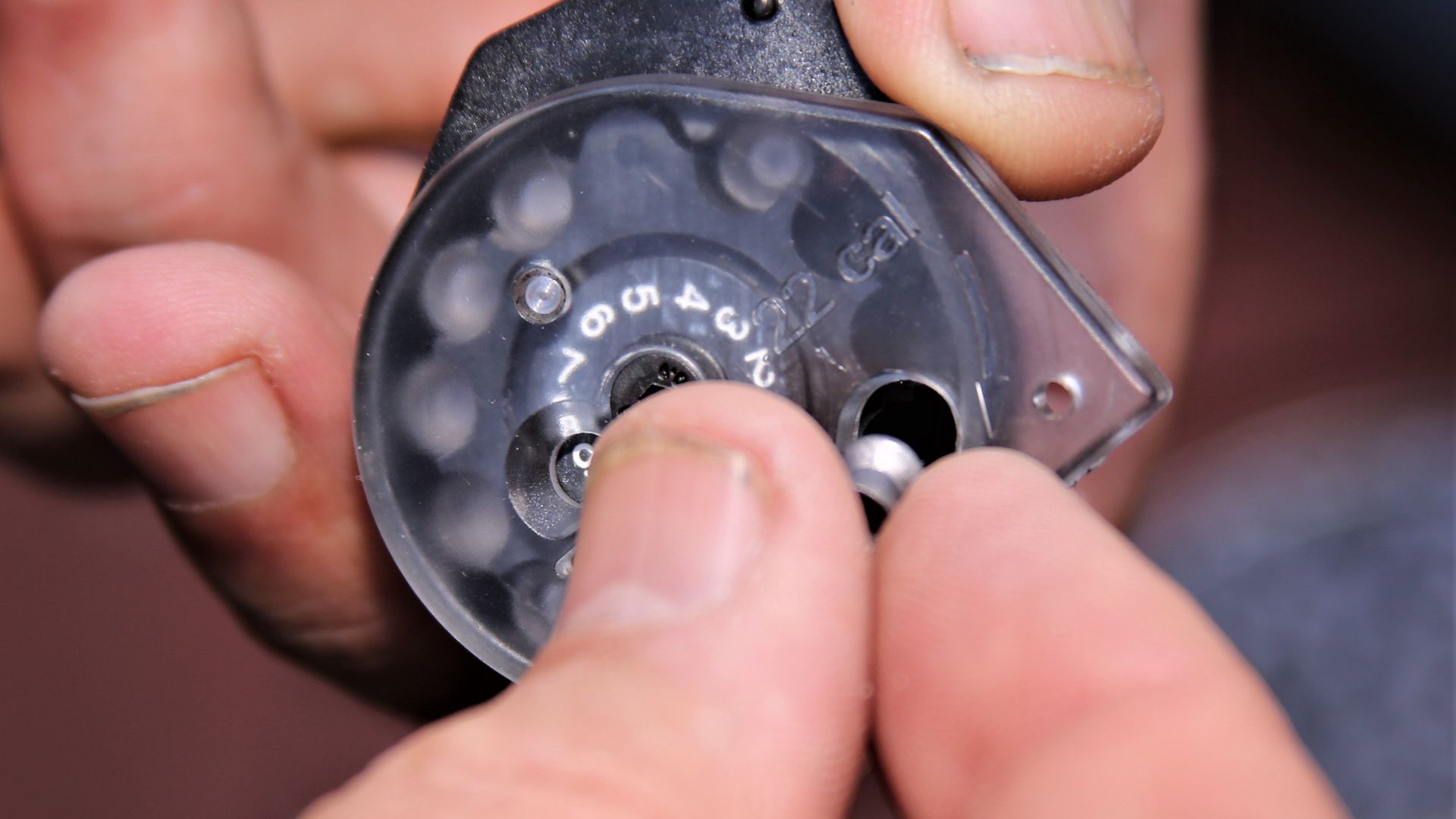 credit: Archant
credit: Archant
LOADING THE MAGAZINE
Most PCP users will have encountered the Knight’s magazine system, and this example is simplicity itself to use. Just pre-tension the internal drive-spring by rotating the clear cover in the direction of the arrow, then lock the pellet-carrier in place by loading the first pellet, nose first, into the empty chamber. Now, fill the remaining chambers, rotating the cover as you do so, until the mag’ is completely loaded.
With the safety set to ‘S’, fully cock the rifle and slide the loaded magazine into its slot in the middle of the action block, until the vertical face of the mag’ is flush with the block. A tiny ‘dimple’ at the beginning of the magazine locator channel makes inserting the mag’ easier, and this is just one of those small, significant touches I mentioned earlier. Once you’ve done it a few times, the whole loading process takes less than a minute per magazine, and it really is extremely simple.
The magazines supplied with the test rifle were quite a snug fit, but they’ve eased off with use and I can slide them in and out without needing to look down. I’m not sure how valuable a technique that is, but it indicates how straightforward it is to load a magazine.
Far more importantly, when the last pellet has been loaded, the sidelever can’t be closed, telling you that the Knight needs a reload. No shooting air at rabbits with this system.
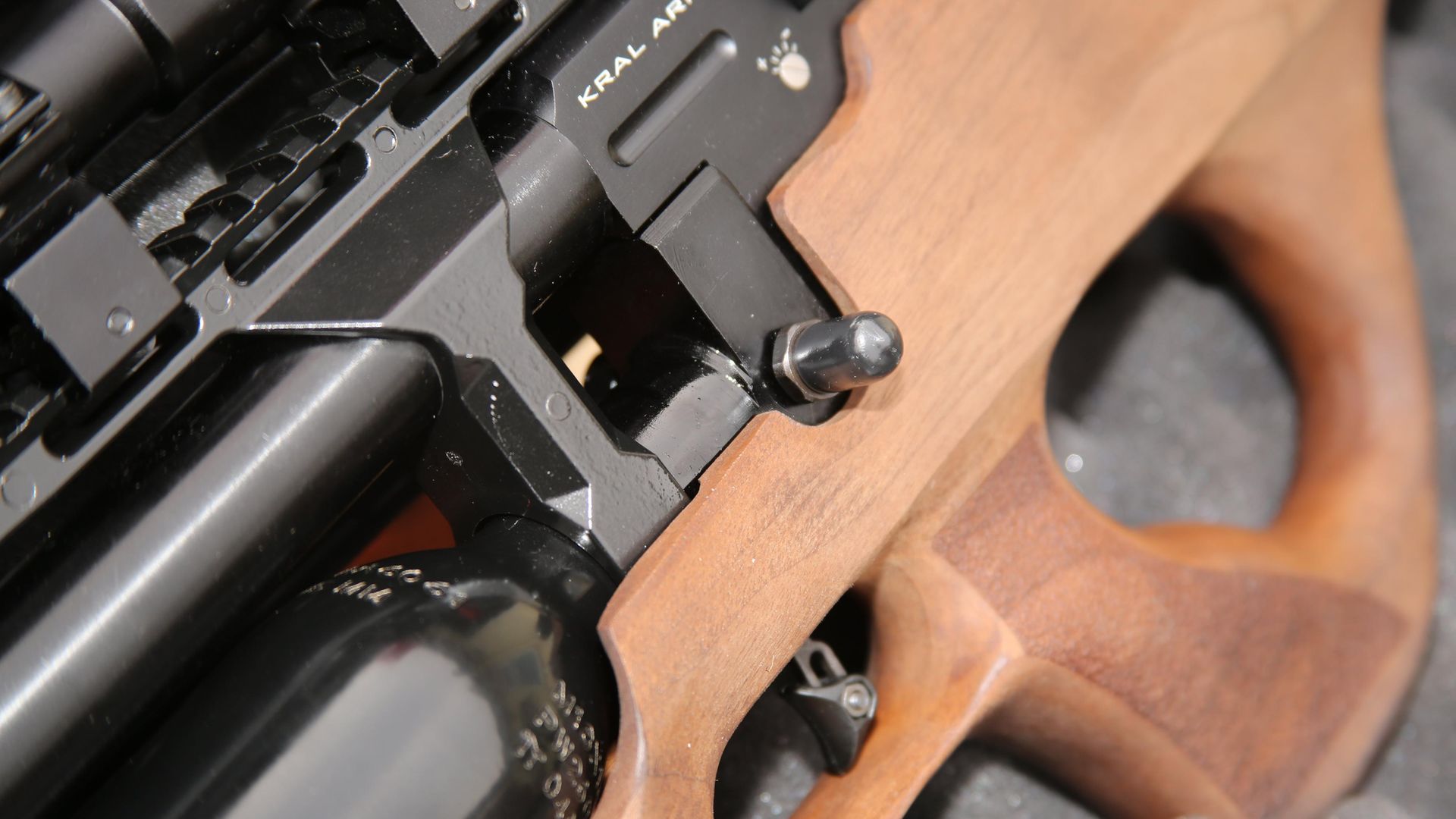 credit: Archant
credit: Archant
ON THE RANGE
The Kral Puncher Knight is an unregulated rifle, with a large air-supply and an efficient, knock-open, self-compensating valving system. This system enjoys a practical degree of self-regulation, even without a separate reg’, and the first 50 shots I put over the chrono returned an overall variation if just 15 f.p.s., from an unsorted tin of Air Arms Diabolo Field pellets. This is impressive, and endorses the test sheet provided with the rifle by its importers, Range Right. That sheet clocked a magazine’s worth of pellets, with an overall spread of 12 f.p.s., and every rifle that leaves Range Right headquarters is individually tested for consistency and the required muzzle energy.
Accuracy is where the Knight impressed me most. Propped on a makeshift bench, with my targets at 35 yards, this .22 rifle puts every correctly-aimed pellet inside a 20mm circle, and it was still doing so 150 shots into the charge. I’d had enough by then and I needed a break, so a mate who was helping me with the photos took over and carried on where I left off. Bar a pulled shot or two when he became excited at how well he was shooting, he pretty much matched what I did. He was genuinely amazed and would have continued shooting for hours had I not needed to be elsewhere. As I write this, my mate is off to buy himself a Kral Knight, and I can see why.
Adjusting the Knight’s trigger is a stock-off job, but it’s easy enough. Just don’t forget to remove the trigger shoe before you lift away the action. As advised in this month’s Follow-Up Test on page 69, don’t cut corners with the trigger adjustment process. Always put the action back in the stock and refit the trigger shoe to test the let-off until it suits you. Yes, it’s a pain, but a half-hour of effort will bring great reward, so don’t compromise, OK?
Once adjusted, the Knight’s two-stage trigger breaks cleanly and consistently, aiding the rifle’s inherent accuracy potential. Should you require further trigger refinement, any competent gunsmith will be able to hone the mechanism for you, but personally, I’m satisfied with it as it is.
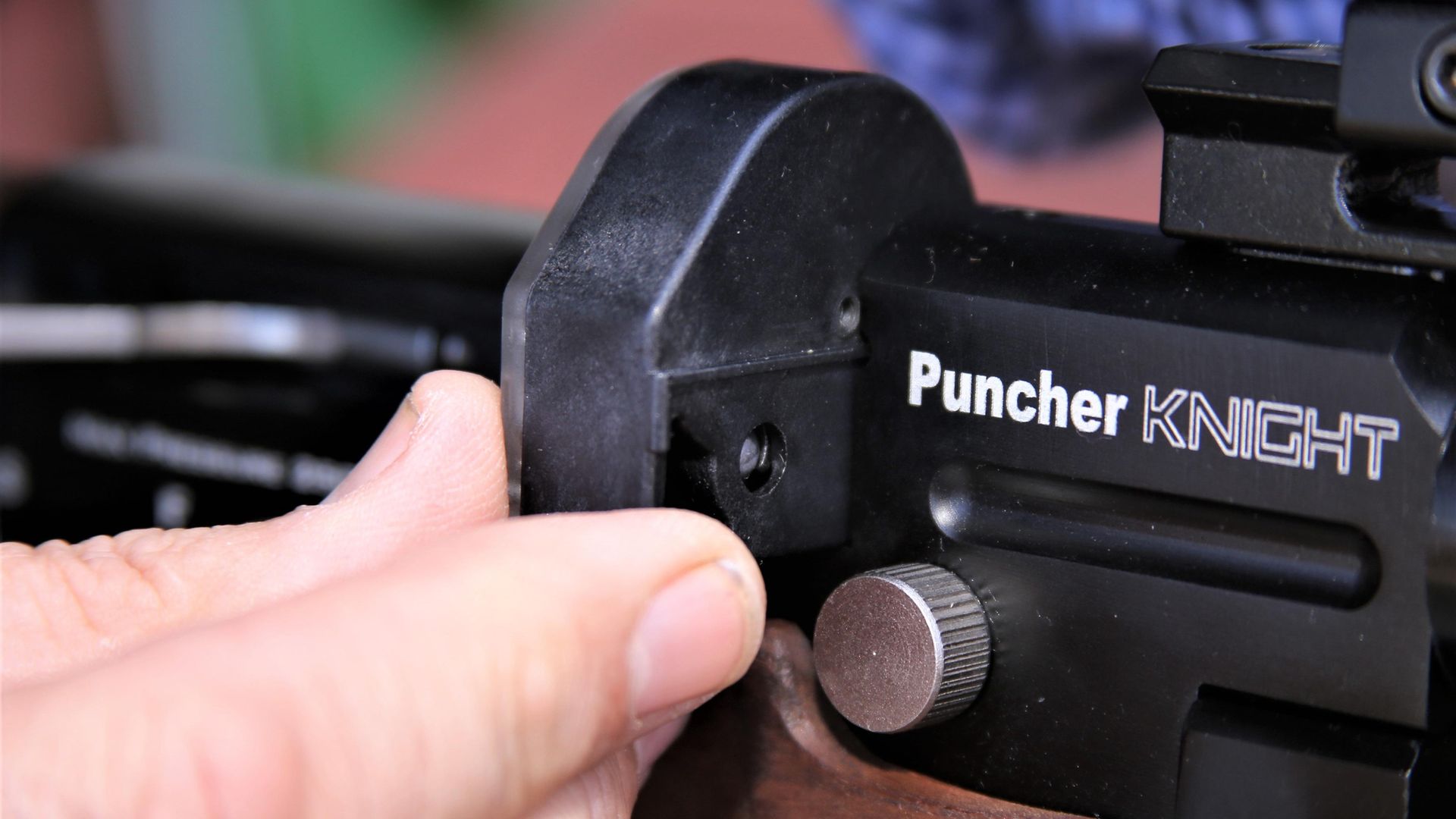 credit: Archant
credit: Archant
INITIAL VERDICT
I said at the beginning of this test that the Knight is the best Kral Arms rifle I’ve tested, and I stand by that statement. There’s more to explore with this rifle, but, those couple of niggles with the charging nozzle and gauge apart, I am incredibly impressed by what’s on offer here for £575, or even less at some outlets.
The test rifle has now had over 1000 pellets through it – the friend I mentioned earlier can’t wait for the one he’s ordered to arrive, so he’s been shooting this one ‘fairly extensively’ – and it seems to love my stash of prepared Air Arms Diabolo Field pellets, although my friend’s Daystate Sovereigns are reportedly matching them.
All in all, this is a remarkable rifle at a remarkable price, and I can’t wait to see just how far I can push its performance – if I can get it back from that mate of mine, that is!
TECHNICAL SPECIFICATION
Model: Puncher Knight
Manufacturer: Kral Arms
Country of origin: Turkey
Price: £575
Type: Pre-charged pneumatic, multi-shot, variable power sporter
Calibre: .22, .177
Cocking/loading: Side-lever
Trigger: 2-stage, adjustable, with manual, resettable, lever-type safety
Stock type: Ambidextrous, walnut, adjustable
Weight: 3.95kg (9lbs) rifle only
Length: 920mm (36.2”)
Barrel: 580mm (19ins)
Filling Pressure: 250bar (3600psi) Max, but 200 bar recommended.
Magazine capacity: 14 for .177, 12 for .22
Shots per charge: approx. 200 in .177 and 230 in .22, at11-plus ft.lbs.
Average energy: 11.6 ft.lbs.
Contact: Range Right